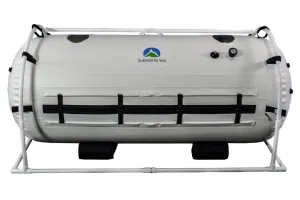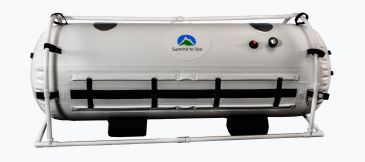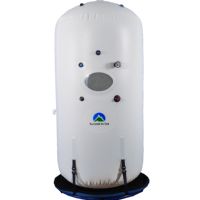 Written by Mike Price, OT
Written by Mike Price, OT
You may think it means sitting in front of the television to watch some of your favorite programs, and while that may be the case for some, others are starting to discover the healing, restorative properties that HBOT (Hyperbaric Oxygen Therapy) has to offer.
The human body is a complex network that runs like a machine. Like most machines, our bodies require some routine maintenance. Hyperbaric oxygen therapy stimulates the body's natural healing processes to boost wound healing and promote cell growth.
With innovations in the hyperbaric therapy market, it's never been easier to find a hyperbaric chamber that meets your exact medical needs, preferences, and budget. This buying guide explores all hyperbaric chamber types, answers frequently asked questions, recommends the best chambers, and is packed full of information to help you make an informed purchase.
One of the first questions people want to know is how much is the price tag. While there is a wide price range, here is a basic breakdown of the costs of hyperbaric chambers.
 | Newtowne Hyperbarics 27 Inch Home Hyperbaric Chamber | Made in USA View Product |
 | Grand Dive Horizontal 40 in. Hyperbaric Chamber by Summit to Sea View Product |
Even if you aren’t looking to buy a super expensive hyperbaric chamber, you can still get a chamber that meets your needs. Don’t worry about breaking the bank; chambers for home use range between $5,000 and $20,000. Adults and children alike can benefit from hyperbaric oxygen therapy, so it’s a great tool to have in the convenience of your house. With a home hyperbaric chamber, you can stay in the comfort of your home and not take any time out of your busy schedule for oxygen therapy.
.jpg&newwidth=365&maxheight=200) | Grand Dive Vertical 54 in. Hyperbaric Chamber by Summit to Sea View Product |
Give your business a boost with this luxurious piece of equipment. Whether you manage a hospital, chiropractor, spa and massage center, gym, senior living community, or wellness center, a professional hyperbaric chamber will give you an edge over your competitors. Professional models are more expensive, but it’s an investment and will add significant, long-term value to your business.
Like many other medical devices and medications, hyperbaric oxygen therapy has “approved uses” and “off-label uses”. The FDA has approved 13 conditions that hyperbaric chambers can effectively treat. Furthermore, there are numerous clinical trials of the effectiveness of hyperbaric oxygen therapy for a plethora of conditions.
There are numerous benefits produced by HBOT. The most common benefits people usually seek involve wound healing, anti-aging, and athletic performance. Below, we go over those topics. To learn more about other HBOT benefits, experience, safety, and science, read our article: Hyperbaric Oxygen Therapy FAQ.
In order for bruises, cuts, breaks, and other more serious injuries to heal, your blood has to carry oxygen to the wound. Hyperbaric oxygen therapy stimulates vasculogenesis, the creation of new blood vessels. HBOT activates the cells that create collagen for the skin’s structure and strength, reducing inflammation, and even destroying harmful bacteria that can invade a wound.
It works for curing both healing and non-healing wounds.
As we age, our bodies naturally begin breaking down. We experience physical symptoms of aging such as lower muscle levels and greater fat tissue buildup; it not only puts us at risk for injury but also limits our independence. As we get older, we also typically experience wrinkles, greater unwanted toxins and debris in our skin, and slowed healing. Mental symptoms, such as declining cognitive skills, are another challenge we face as we age.
Aa an off-label use for hyperbaric chambers is to combat these typical aging characteristics by establishing healthy blood circulation, repairing damaged skin cells, regenerating tissue, and fighting infections.
LeBron James and Michael Phelps are among the many athletes who use hyperbaric therapy. Just as hyperbaric chambers allow aging adults to live at their best, they can help athletes perform at their best. Top athletes put their bodies through a lot of stress. Between rigorous workouts and the strain of an on-the-go lifestyle, athletes can benefit from the substantial support that hyperbaric oxygen therapy provides. In addition to greater physical performance, less post-workout muscle soreness, and a shorter recovery time, hyperbaric oxygen therapy provides mental clarity, reduces inflammation, and improves sleep. All of these benefits factor into athletic performance and allow professional athletes to compete better.
Hyperbaric chambers use two methods in order to move oxygen from the air around us into our bodies.
Increasing inspired oxygen concentration, or the oxygen you breathe in, and increasing ambient pressure. In other words, the greater the oxygen concentration and room pressure, the more oxygen our body retains to power our bodily functions.
Naturally, the air we breathe is only 21% oxygen. The other 79% of ambient air around us is a mixture of gases, such as nitrogen, and those gases do not power our bodies in the same way oxygen does. For all home chambers upwards of 90% to 95% concentrated oxygen is administered straight from an oxygen concentrator directly to the patient via a nasal cannula or face mask. While you are receiving mostly concentrated oxygen, fresh air circulates inside of the chamber, which prevents a build-up of our exhaled breath, or carbon dioxide.
In rare occasions, hospitals use another method to administer oxygen to patients receiving HBOT. Rather than using a nasal cannula or face mask, hospitals might oxygenate the entire inside of the chamber. As most of us know, oxygen is highly flammable, so having an entire chamber filled with concentrated oxygen poses numerous danger liabilities. In addition, there are many safety standards that a hospital must comply with if using this method. As a result, this method is rarely used due to multiple risks and safety hazards.
 | Home Hyperbaric Chamber by Newtowne Hyperbarics - 34 Inch | Made in USA View Product |
The air that surrounds us has weight and it presses everything it touches. Scientifically, the air pressure is called atmospheric pressure, and this pressure is commonly measured in a unit called Atmospheres Absolute (ATA).
In order to work, hyperbaric chambers must create a pressure inside the cabin that is greater than our atmospheric pressure. This means the pressure during hyperbaric oxygen therapy must be greater than the air we typically breathe, which is 1 ATA. Most hyperbaric chambers create between 1.35 to 2 ATA.
Increased air pressure helps increase the amount of oxygen your body absorbs. In order to use the oxygen we breathe, tiny sacs in our lungs must transfer it into the bloodstream. As the pressure increases, so does the ability to absorb it into our blood for use throughout our entire bodies!
Other than ATA, another unit of pressure is pounds per square inch, or PSI. Many people refer to PSI when referring to their car’s tire pressure. ATA and PSI are both units of measurement that measure air pressure; they are similar to how we use both feet and inches to measure length. Our atmospheric pressure is 1 ATA and 14.7 PSI.
The standard ATA for hyperbaric chambers is 1.3 ATA. However, someone who requires significant healing such as severe tissue injury, bone damage, or bacterial infection may want a chamber with a higher ATA.
Most people can benefit from hyperbaric oxygen therapy. It is considered well-tolerated and safe. Negative outcomes are rare, however, it is still important to be aware of the risks just in case. Here is a list of side effects that some patients experience.
Prior to receiving hyperbaric oxygen therapy, it is extremely important that you eat a nutritious meal and drink lots of water. Treatment is likely to be more effective if you are hydrated prior to your appointment. It is also recommended that you avoid both nicotine and caffeine as they cause your blood vessels to narrow, reducing a hyperbaric chamber’s effectiveness. If your blood vessels are thinner, your body will not be able to absorb as much oxygen. A large part of the way hyperbaric oxygen therapy works is to increase oxygen absorption by your blood vessels: both nicotine and caffeine impede that. If you are unable to quit tobacco or caffeine use completely, avoid it for as long as possible before and after each treatment. Once your treatment is over, there are no additional limitations to your activities or diet.
Depending on the type of chamber, you might be lying down or sitting upright during treatment. It is recommended that you wear loose, cotton clothing to ensure comfortability. It is also recommended to bring something inside the chamber to pass the time, such as a book or puzzle.
In most home chambers, the chamber’s cabin is pressurized with room air, and oxygen is administered via cannula or mask; therefore, concentrated oxygen does not build up inside the cabin and does not create a flammable environment. With these chambers, it is safe to use electronics, such as a smartphone, laptop, or e-book reader while inside the chamber. Some manufacturers do caution the use of smartphones with broken screens or older mobile phones while inside a chamber.
On rare occasions, some hospitals might pressurize their hyperbaric chambers with upwards of 95% pure oxygen. If you are receiving treatment in one of these chambers, there is a long list of items that are prohibited due to flammability. Some of these items include all electronics including smartphones, perfume, hairspray, oil-based and petroleum-based products, hearing aids, and more. If you are receiving hyperbaric treatment at a hospital, consult with your doctor regarding how to prepare and restrictions.
For more information, check out How Do You Prepare for Hyperbaric Therapy? (ANSWERED). In this article, we go over all the preparations you need to make prior to, during, and after home hyperbaric treatment.
The duration of each treatment and the total recommended number of sessions vary based on the health condition you are treating and your overall goal for therapy. Hyperbaric oxygen therapy can be as short as 3 minutes or last several hours depending on the reason for treatment and pressure level used. For many conditions, doctors recommend daily therapy for 4-6 weeks.
Hyperbaric oxygen therapy treating wound healing, for instance, typically consists of 90-minute sessions at around 35 ppi. The oxygen is delivered in 20-30 minute intervals with 5-minute breaks. During these breaks, the patient can open the chamber and drink water. Depending on the severity of the wound, between 20 and 40 sessions is recommended.
On the other hand, divers with decompression sickness are typically treated for 5 to 8 hours and receive just 2-3 sessions. During hyperbaric oxygen therapy for decompression sickness, as time progresses in the treatment, the hyperbaric chamber is slowly depressurized to allow it to adjust to the pressure. For carbon monoxide poisoning, the treatment is usually around 90 minutes and requires approximately 3 sessions.
The recommendations listed are generalized, so for best use and safety please consult a doctor to determine the length and frequency of your sessions.
 | Newtowne Hyperbarics 27 Inch Home Hyperbaric Chamber | Made in USA View Product |
In a low ATA setting, you can stay inside a hyperbaric chamber for longer periods of time. As the pressure increases, the recommended therapy duration shortens. Some people decide to undergo hyperbaric oxygen therapy overnight while sleeping. Athletes, in particular, commonly utilize this method. It is possible to do so safely as long as the chamber is at a low pressure.
Generally, sleeping in a hyperbaric chamber has no added health benefits when compared to shorter sessions at a higher pressure but may be more comfortable for the user. To determine more specific recommended treatment lengths, pressures, and frequencies, you should consult a doctor or other certified professional.
This is a difficult question because there isn’t a black-or-white answer. As you can see by now, there isn’t a ‘one-size-fits-all’ hyperbaric treatment, therefore, outcomes vary for each user. It is important to note that the lasting effects of hyperbaric oxygen therapy vary greatly based on the health condition you are treating and your goal for therapy. Additionally, while the majority of research supports its use for healing purposes, numerous off-label uses are also acknowledged.
While hyperbaric oxygen therapy can be very beneficial, it is not for everyone. You shouldn’t receive treatment if you have the following:
 | Grand Dive Horizontal 40 in. Hyperbaric Chamber by Summit to Sea View Product |
Hyperbaric oxygen therapy is not limited to adults; it can be beneficial for children as well. If a child is experiencing carbon monoxide poisoning, is suffering from a non-healing wound, or facing another condition like those previously discussed, hyperbaric oxygen therapy may be a fitting treatment. While research has been conducted about hyperbaric oxygen therapy’s effectiveness for developmental disorders such as autism or cerebral palsy, hyperbaric therapy is not an FDA-approved use for those disorders. We highly recommend speaking with a healthcare professional prior to treatment, especially when determining use for children, to ensure hyperbaric oxygen therapy will not only be beneficial, but safe.
When you are in a hyperbaric oxygen chamber, the pressure causes your ears to pop and you may feel sinus pressure. Imagine a similar feeling to your ears popping while on an airplane. While it’s not a big deal to most adults, it can be scary for children. It is recommended that if you plan on your child using a hyperbaric chamber, you should purchase a chamber that is large enough to fit at least 1 adult and 1 child. Having an adult inside the chamber will help ease and comfort the child during treatment.
There are several different kinds of hyperbaric chambers, each with its own benefits and drawbacks. In order to find a chamber that meets your needs, consider the differences between hard and soft hyperbaric chambers, as well as monoplace and multiplace chambers. If you are purchasing a hyperbaric chamber for your home, check out How to Choose the Best Hyperbaric Oxygen Therapy Chamber!
 | Hard Shell Hyperbaric Chamber with Removable Stretcher- Revitalair 430F by Biobarica View Product |
Hard chambers are usually purchased by hospitals, clinics, and wellness centers. You may not have seen one in person yourself, but they've been featured on TV shows such as Grey’s Anatomy! Hard chambers tend to be larger, which is ideal if medical professionals need to set bulky medical devices inside the chamber during treatment. Additionally, athletes prefer larger chambers because it allows them the space to work out and even set gym equipment inside the chamber.
As their name suggests, hard hyperbaric chambers are not flexible and they retain their shape whether they are inflated or deflated. Due to this, they are usually more comfortable to enter and exit.
Some users prefer hard chambers because they can reach a higher ATA. Hard chambers can reach up to 2+ ATA while soft chambers max out at 1.4 ATA. Keep in mind that just because a chamber can reach a higher ATA doesn’t necessarily mean it’s a better chamber. The ATA required for treatment is dependent upon each patient’s health condition and their goal for therapy.
 | Grand Dive Horizontal 40 in. Hyperbaric Chamber by Summit to Sea View Product |
Soft chambers are often purchased for home use, gyms, spas, traveling doctors, and other various businesses. Soft chambers are loved for their price point and portability. While some soft chambers are specifically designed for on-the-go use with an easy break-down design and included travel bag, all soft chambers can be portable.
Soft hyperbaric chambers are often referred to as ‘portable hyperbaric chambers’ and ‘mild hyperbaric chambers'. They get the nickname ‘mild hyperbaric chambers’ because they reach a maximum ATA of 1.4. Whereas hard chambers can reach more than 2 ATA. As stated before, a higher ATA does not equate to being the best chamber. In fact, 1.35 ATA is the standard hyperbaric pressure for most patients. The ATA needed is dependent upon each patient’s needs.
Soft hyperbaric chambers look like an inflatable bag and are held in place by metal or PVC rods. When you enter a deflated, soft chamber, it can feel awkward at first. Imagine walking inside a camping tent that is only halfway set up. For some users, it can feel claustrophobic until the chamber is inflated.
.jpg&newwidth=365&maxheight=200) | Grand Dive Vertical 54 in. Hyperbaric Chamber by Summit to Sea View Product |
A vertical chamber allows you to sit upright in a chair while receiving hyperbaric oxygen treatment. A vertical chamber is best for patients in wheelchairs or patients that need to remain upright while receiving treatment, due to a medical condition. All vertical chambers are soft.
The terms ‘monoplace’ and ‘multiplace’ refer to the number of patients that can fit inside a chamber during treatment. In accordance with their names, monoplace hyperbaric chambers fit 1 patient, while multiplace hyperbaric chambers can accommodate multiple patients.
 | Summit to Sea Dive 33 in Hyperbaric Chamber View Product |
 | SOFT Multiplace Grand Dive Pro Hyperbaric Chamber, 46 in. by Summit to Sea View Product |
 | Wheelchair Accessible - Grand Dive Pro Plus Hyperbaric Chamber by Summit to Sea View Product |
 | Hard Shell Hyperbaric Chamber with Removable Stretcher- Revitalair 430F by Biobarica View Product |
Based on each user’s unique mobility capabilities, the perfect hyperbaric chamber may vary. Many hyperbaric oxygen chambers are built with mobility in mind and are specialized for specific medical conditions. Some chambers allow you to sit upright, boast roll-in stretchers, or are even wheelchair accessible. Comfort is key, so make sure you get what’s best for you!
 | Dive Vertical 40 in Hyperbaric Chamber for Sitting Up - by Summit to Sea View Product |
PTSD is caused by traumatic events that alter the brain’s structure. The result is a “non-healing brain wound”, which can be seen using functional imaging. While many therapies focus on managing PTSD symptoms, currently there is no cure for PTSD. In recent years, there have been clinical trials that study the effectiveness of hyperbaric oxygen therapy for PTSD.
Although it’s not an FDA-approved treatment, many veterans claim HBOT helps their PTSD. As a matter of fact, some believe so strongly in hyperbaric therapy for PTSD that there is a pending Veterans National Traumatic Brain Injury Treatment Act. Hyperbaric therapy could also be beneficial for people who might experience PTSD in their jobs, such as EMTs, firefighters, police, etc. Lastly, in the spirit of transparency, there is some controversy on both sides of the discussion about using hyperbaric oxygen therapy for PTSD.
Summit to Sea offers a discount for all military, first responders, and police. We do not have the discounted prices posted on our website, so please email quotes@rehabmart.com to obtain this discount! Please note that applicable ID verification will be required.
Newtowne has a few specific models of chambers that have special discounts for all military, fire, police, EMTs, and their families. The prices are already on our website, and you can checkout without any assistance. Once you place your order, please note that applicable ID verification will be required.
There are many brands of hyperbaric chambers on the market. Here are a few companies that are FDA-cleared. If you are interested in learning more about our brands, check out Who Manufactures Hyperbaric Chambers? for details on each brand!

Co-Founder of Rehabmart and an Occupational Therapist since 1993. Mike has spent his professional career working in multiple areas of Occupational Therapy, including pediatrics, geriatrics, hand therapy, ergonomics and inpatient / outpatient rehabilitation. Mike enjoys writing articles that help people solve complex therapeutic problems and make better product choices.